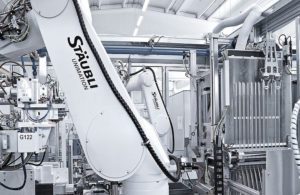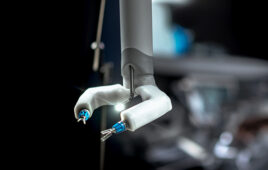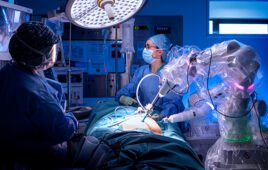As industry 4.0 evolves, medical manufacturers are finding six-axis robots valuable all along the production line.
Oliver Cremoux, Stäubli Corp.

Italian manufacturer Elettrosystem uses a six-axis robot to manufacture specialized spiral tubing. [Image courtesy of Stäubli]
Device manufacturers are faced with strict regulations to maintain tight tolerances and reproducibility. To keep up with the pace of innovation, medical manufacturers must be able to change manufacturing lines when new products are needing to be developed. They also require consistency in the quality of the production press and high repeatability with minimized risks of human errors. Robotics offer manufacturers modular systems that promote efficiency and workflow, as well as high repeatability.
Automation of spiral-tubing manufacture
As an example of the capabilities of six-axis robots, consider an endotracheal tubing product created by systems integrator, Elettrosystem. The system was once considered so complex as to be beyond the scope of automation. But four six-axis robots have created a production line for the sophisticated process.
The spiral tube is a special hollow probe, which is used in anesthesia as well as in intensive care medicine. In the case of the automation solution implemented by Elettrosystem, a fine steel coil spring is wound onto a PVC tube, and an adhesive sheath is then applied. The unique challenge here lies in the strictly defined uniform distribution of the spring windings as well as in the handling of the two flexible components.
The plant for the simultaneous production of four spiral tubes consists of two cells in a mirror-image layout. The complicated winding of the spring takes place in an integrated process circuit, which is linked via linear systems. The robotic arms require exemplary precision and path accuracy.
Surface treatments, testing and cleanroom capabilities
The polishing of orthopedic implants is one of many high-precision applications in robotics. Established providers rely on six-axis robots which can achieve the accuracy required for high-precision machining to tight tolerances of three-hundredths of a millimeter.
The robots can also test inhalers and their components to destruction inside a compact robot cell.
When production runs are in the millions of units, the most stringent safety and quality standards apply. Tensile and high-pressure testing operates in parallel with production under cleanroom conditions.
Parts to be tested can be handled by a cleanroom robotic arm. This automation of testing represents a quantum leap. In addition to a significant increase in productivity, the system facilitates adherence to the highest quality standards under reliably reproducible conditions.
The fast pace of six-axis machine ensures low cycle times. Furthermore, the cell boasts ease of service and maintenance as well as low-energy consumption. Used in combination with refined solutions, the compact and reliable robotic arms can provide inspection quality and product safety within a confined space.
Conclusion
Robots cover a wild scope of applications in the medtech industry. Increasingly, we are seeing additional uses, not only on the manufacturing floor and research labs, but also as a new trend in the surgical field and in hospital automation. For example, Arxium recently developed an automated compounded pharmacy solution. With new robots capable of working in aseptic environments at high speed, we also see a strong evolution in pharma production processes.
Olivier Cremoux, business development manager, North America, joined Stäubli in 2015. Cremoux started with Stäubli as an international business development manager in France, where he was instrumental in developing key accounts and implementing a strategy based on market segmentation and targeted applications for Stäubli Robotics. Cremoux focused on the development of markets in Brazil, Czech Republic, India, Singapore and Thailand before shifting his focus to North America.
The opinions expressed in this blog post are the author’s only and do not necessarily reflect those of Medical Design and Outsourcing or its employees.




